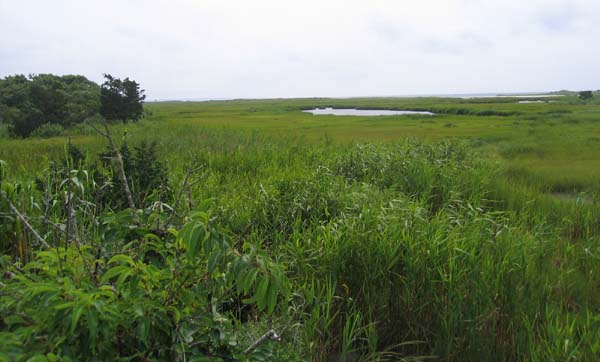Buzzards Bay is a special coastal region in the Commonwealth of Massachusetts. The jagged border of Buzzards Bay bound by the glacial deposits that form the Elizabeth Islands creates many diverse environments around the bay. The coastal zone of Buzzards Bay is characterized by a variety of important habitats including salt marshes, tidal streams, eelgrass beds, tidal flats, barrier beaches, rocky shores, and a number of subtidal habitats. Buzzards Bay is within the Virginian Biological Province, which means that the species in Buzzards Bay are typical of those found along the east coast between Chesapeake Bay and Cape Cod. The Cape Cod Canal, however, forms a direct tie to the cold-water species found north of Cape Cod. For these reasons, a unique mix of semi-tropical and Arcadian species can be found in Buzzards Bay during different times of year.
Salt marshes are among the most productive ecosystems in the world even exceeding most types of agricultural land. For a long time salt marshes and tidal areas were considered unproductive land to be filled. Today they are among the most highly protected wetland types in Massachusetts and enjoy stringent protections. They are recognized as an important resource that provides wildlife habitat, produces large quantities of plant and animal biomass, exports food to nearby coastal food webs, protects the coastal zone from floods, and absorbs some water-borne contaminants.
Beds of subtidal eelgrass (Zostera marina), like salt marshes, are important food production and nursery are-as. This perennial plant is found in waters of varying salinity, growing in sand or mud (typical shallow bed shown in Figure 10), in depths ranging from just under low-tide level to 20 feet below sea level in places where sunlight penetrates to the ocean floor and current or wave action is not too severe. Eelgrass flourishes in salt ponds, bays, and at the mouths of estuaries and tidal creeks.
Tidal flats are found in estuaries and quiet bays, be-hind barrier beaches, in salt ponds, and, depending on slope, below the depth of wave disturbance along the open shores of Buzzards Bay. These shallow, sloping flats exist in a range of salinities from the coastal areas to the upper reaches of the estuary. The substrate is com-posed of materials ranging from very fine silt and clay to coarse sands. It is the combination of salinity, substrate quality, and character of water movement over the flat that determines the species composition of plants and animals.
Barrier beaches are formed from sand and gravel transported by waves from a sediment source. Typically, they begin as sand spits that grow out from and parallel to the shore. Barrier beaches are usually long and narrow; they may be barely elevated above the level of high tide, or they may contain high dunes. Barrier beaches can become islands when storms breach their connection to the uplands.
The fisheries of the bay include lobster, shellfish, and finfish. The commercial and recreational shellfisheries of Buzzards Bay include quahog (Mercenaria mercenaria), bay scallop (Argopecten irradians), soft-shell clam (Mya arenaria), and oyster (Crassostrea virginica). Buzzards Bay is recognized as a highly valuable re-source area for the many species of finfish that inhabit the bay, and is a habitat for those species that migrate north during the spring and summer. Its numerous inlets, coves, and freshwater streams are rich with small fish (minnows, sand eels, silversides, and alewives) that at-tract the larger recreational species. Salt marshes and eelgrass beds offer protection to many species of young fish, some of which are commercially important.
Click on one of the sub-page links on the right for more information on that natural resource.

July 2006 Photograph of a Salt Marsh in Wareham, MA. Photo credit Joe Costa